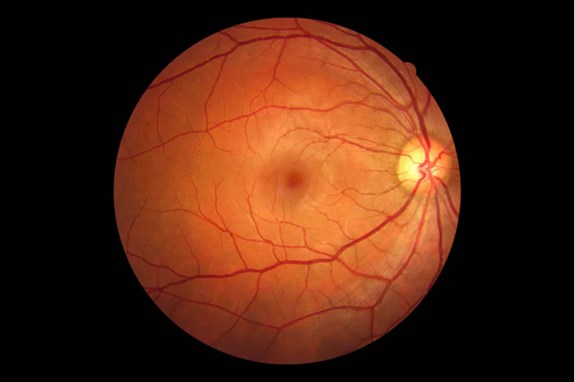Marika Eriksson's doctoral dissertation provides a comprehensive understanding of how blood pressure, diabetic retinopathy and haptoglobin genotype are related to cerebral small-vessel disease in people with type 1 diabetes. The purpose of her doctoral dissertation is to contribute to information that increases our understanding of how damage to the vessels of the brain occurs in type 1 diabetes and, above all, how we prevent this.
People with type 1 diabetes have an increased risk of developing cerebral circulatory disorders, such as stroke. The proportion of cerebral circulatory disorders that originate in small-vessel disease is several times greater in people with type 1 diabetes compared with the rest of the population. Cerebral small-vessel disease is a condition that affects the smallest vessels in the brain. The disease has been associated with memory disorder, but may also be completely asymptomatic. It is also a significant risk factor for stroke.
The purpose of the doctoral dissertation is to contribute to information that increases our understanding of how damage to the vessels of the brain occurs in type 1 diabetes and, above all, how we prevent this.
Cerebral small-vessel disease can be examined with magnetic resonance imaging (MRI). A challenge in examining the disease is that conventional imaging methods only illustrate markers of the disease, not the affected vessels themselves. These markers include microbleeds in the brain, white matter changes, and so-called lacunar infarcts. Examination via these markers means that the disease can only be diagnosed when tissue damage has already occurred.
In 2010, a research collaboration was initiated between the research group FinnDiane and the Helsinki University Hospital. The purpose of the collaboration is to carry out a follow-up study that accurately maps asymptomatic cerebral small-vessel disease using brain MRI. The MRI study, which includes 191 people with type 1 diabetes and 30 healthy people in the control group, has shown that cerebral small-vessel disease occurs more often in people with type 1 diabetes than among healthy people.
People with small-vessel disease also more frequently had high blood pressure at night as well as so called masked hypertension - normal blood pressure when measured at the doctor's office, but high blood pressure otherwise.
Marika Eriksson, FHRC, physician and doctoral student at FinnDiane, has been part of the project for a long time.
– I started my research work with FinnDiane as a medicine candidate in 2017, with Lena Thorn as supervisor. Later, I was also supervised by Per-Henrik Groop and Juha Martola. The goal of my work was then, as part of the MRI study, to more closely investigate the role of blood pressure in cerebral small-vessel disease in type 1 diabetes, says Eriksson.

In the study, Eriksson analyzed results from the blood pressure follow-up in relation to findings in brain MRI examinations. She found that people with cerebral small-vessel disease had higher systolic and diastolic blood pressure at night compared to people without small vessel disease. People with small-vessel disease also more frequently had high blood pressure at night as well as so called masked hypertension - normal blood pressure when measured at the doctor's office, but high blood pressure otherwise.
– This gave us reason to suspect that blood pressure measurements performed at the clinic do not sufficiently rule out high blood pressure among these people, says Eriksson.
With her work on the blood pressure and cerebral small-vessel disease study, Eriksson became interested in continuing research on cerebral circulatory disorders in type 1 diabetes. After graduating from the Faculty of Medicine in the spring of 2019, Eriksson was accepted as a doctoral student at the University of Helsinki's Graduate School of Clinical Research. The goal is a doctoral dissertation, in which the study of the role of blood pressure in cerebral small-vessel disease constitutes the first part of the work.
So far, only a few studies have examined cerebral small-vessel disease in type 1 diabetes. Previous studies have indicated that the changes in the vessels of the brain represent a generalized condition of blood vessel disease, which involves several of the body's tissues.
– This hypothesis is based on the fact that a connection has previously been seen between severe diabetic retinopathy, a diabetic complication that affects the retinal blood vessels and damages the visual sense along with microbleeds in the brain, says Eriksson.

It has often been suggested that retinal blood vessels in the eye may reflect the condition of the small blood vessels of the brain, but the association is still relatively unexplored among populations with type 1 diabetes. Unlike the small blood vessels of the brain, the small vessels of the retina are directly visible. This allows photography of the vessels (fundus photography) and evaluation of their condition without invasive procedures or the use of contrast agents. Because diabetic retinopathy is the most common complication of diabetes, fundus photography is routinely done on people with diabetes.
– The availability of fundus images and the visibility of the retinal blood vessels make the retina an interesting research object in the effort to increase knowledge about cerebral circulatory disorders in type 1 diabetes. Since cerebral small-vessel disease has previously been associated with severe diabetic retinopathy, we at FinnDiane are interested in further investigating the connection. Within the framework of my doctoral studies, we have studied the connection in a second part of the project, with the aim of investigating how the severity of diabetic retinopathy relates to cerebral small-vessel disease, says Eriksson.
For the second part of Eriksson’s dissertation, all participants in the MRI study were included, for whom fundus photographs were available. A total of 189 individuals with diabetes and 29 in the control group. When evaluating the images, the Early Treatment Diabetic Retinopathy Study (ETDRS) grading scale was applied, where increased scores indicate more severe eye disease. The participants' ETDRS scores were then analyzed in relation to the MRI findings.
In addition to the fact that cerebral small-vessel disease has been associated with other diabetic complications, such as retinopathy, it has also been suggested that the disease is related to genetic factors, hereditary predisposition.
Although Eriksson, through her research, has shown that the severity of retinopathy is associated with cerebral small-vessel disease, the significance of this association, e.g. how it relates to stroke, is hitherto unknown.
– Within the framework of my doctoral dissertation, I will further investigate this by examining the relationship between the severity of diabetic retinopathy according to ETDRS and the incidence of stroke in the extensive follow-up data available within FinnDiane, says Eriksson.
In addition to the fact that cerebral small-vessel disease has been associated with other diabetic complications, such as retinopathy, it has also been suggested that the disease is related to genetic factors, hereditary predisposition. One genetic factor associated with cerebral small-vessel disease in type 1 diabetes is variation in the gene encoding haptoglobin.
– Haptoglobin is a protein that binds to free hemoglobin in the blood and, among other things, prevents oxidative activity. It is known that the structure and antioxidant properties of the protein vary depending on the genotype of a person. So far, there is only a limited amount of data on how this relates to the prevalence of small-vessel disease. Therefore, we have also investigated this connection within the framework of my doctoral dissertation. In any case, our preliminary, unpublished results do not indicate any connection, says Eriksson.
Marika Eriksson's doctoral dissertation will contribute with a comprehensive picture of how blood pressure, diabetic retinopathy and haptoglobin genotype are related to cerebral small-vessel disease in people with type 1 diabetes. The purpose of her dissertation is to contribute to information that increases our understanding of how damage to the vessels of the brain occurs in type 1 diabetes and, above all, how we prevent this.
Simon Granroth, Science Communicator
